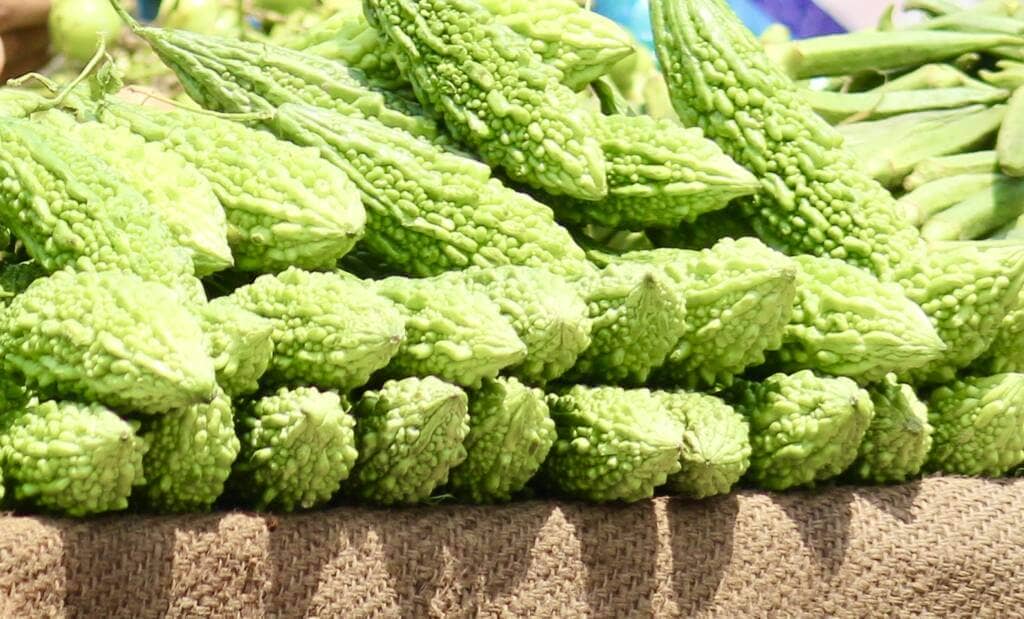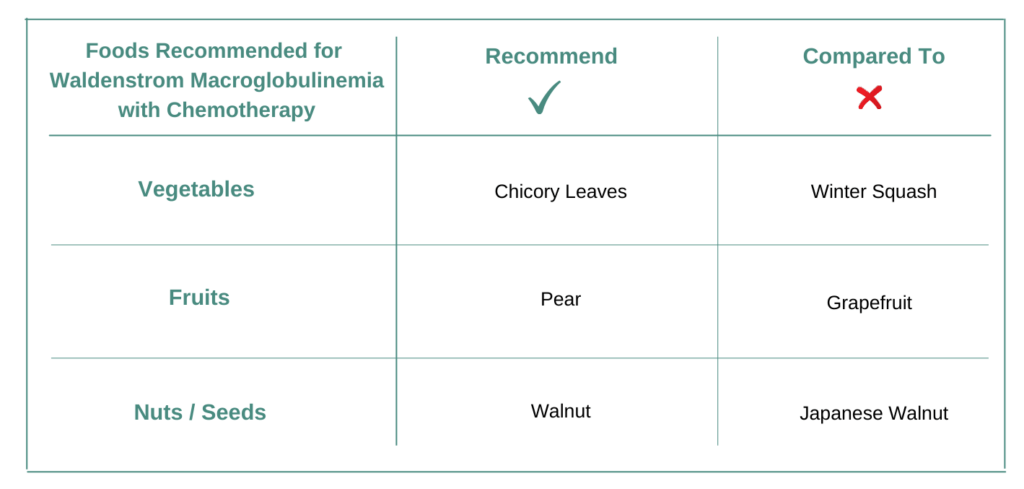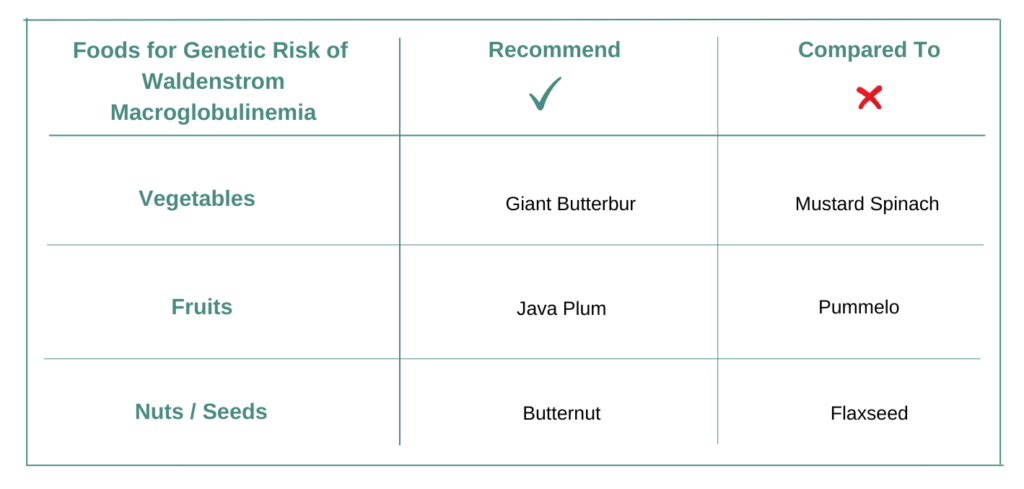Introduction
Foods for Waldenstrom Macroglobulinemia should be personalized for each individual and also must adapt when cancer treatment or tumor genetic change. The personalization and adaptation must consider all the active ingredients or bioactives contained in different foods with respect to cancer tissue biology, genetics, treatments, lifestyle conditions and diet preferences. Hence while nutrition is one of the very important decisions for a cancer patient and individual at risk of cancer to make – how to choose foods to eat is not an easy task.
Waldenstrom macroglobulinemia is a rare, chronic blood disorder that affects white blood cells (lymphocytes). It is a type of non-Hodgkin lymphoma. It is also called lymphoplasmacytic lymphoma. It is a rare, slow growing blood cancer which is characterized by the presence of high levels of a macroglobulin (immunoglobin M [IgM]. The M protein thickens the blood, affecting the flow of blood through the tiny blood vessels, a rare condition unique to Waldenstrom macroglobulinemia called the hyper viscosity syndrome. The viscous serum can sometimes cause tears in the tiny blood vessels, causing nose, gums, or the retinas in the eyes to ooze blood. In addition, the bone marrow keeps filling up with the abnormal cells and crowding out the normal blood cells leading to reduced functional red blood cells, neutrophils and platelets and causing cytopenic conditions such as anemia, neutropenia, and thrombocytopenia. These conditions effect the body’s ability to fight infection, and to bleed and bruise more easily. Symptoms of Waldenstrom macroglobulinemia include fatigue, fever, loss of appetite, night sweats, weakness, nosebleeds, blurred vision, enlarged liver or spleen and swollen lymph nodes. One of the key underlying causes for Waldenstrom macroglobulinemia in 90% of the diagnosed patients is a mutation in the gene MYD88. The 5-year survival rate for patients diagnosed with this condition is 78% (American Cancer Society, 2022). Treatment options for Waldenstrom macroglobulinemia include plasmapheresis (plasma exchange), chemotherapy, immunotherapy, targeted therapy, radiation therapy and stem cell or bone marrow transplant. Additionally, the right nutrition (foods and natural supplements) aligned to cancer stage and treatment context can enhance patients’ well-being.
For Waldenstrom Macroglobulinemia does it matter what vegetables, fruits, nuts, seeds one eats?
A very common nutrition question asked by cancer patients and individuals at-genetic risk of cancer is – for cancers like Waldenstrom Macroglobulinemia does it matter what foods I eat and which I do not? Or if I follow a plant-based diet is that enough for cancer like Waldenstrom Macroglobulinemia?
For example does it matter if vegetable Chicory Leaves is consumed more compared to Winter Squash? Does it make any difference if fruit Grapefruit is preferred over Pear? Also if similar choices are made for nuts/seeds like Walnut over Japanese Walnut and for pulses like Cowpea over White Lupine. And if what I eat matters – then how does one identify foods which are recommended for Waldenstrom Macroglobulinemia and is it the same answer for everyone with the same diagnosis or genetic risk?
Yes! Foods you eat matters for Waldenstrom Macroglobulinemia!
Food recommendations may not be the same for everyone and can be different even for the same diagnosis and genetic risk.

All foods (vegetables, fruits, nuts, seeds, pulses, oils etc.) and nutritional supplements are made up of more than one active molecular ingredient or bio-actives in different proportions and quantities. Each active ingredient has a unique mechanism of action – which can be activation or inhibition of different biochemical pathways. Simply stated foods and supplements which are recommended are those which do not cause an increase of molecular drivers of cancer but reduce them. Else those foods should not be recommended. Foods contain multiple active ingredients – hence when evaluating foods and supplements you need to consider the impact of all active ingredients cumulatively rather than individually.
For example Grapefruit contains active ingredients Chlorogenic Acid, Ferulic Acid, Curcumin, Isoliquiritigenin, Delphinidin. And Pear contains active ingredients Chlorogenic Acid, Gallic Acid, Isoliquiritigenin, Curcumin, Genistein and possibly others.
A common mistake made when deciding and choosing foods to eat for Waldenstrom Macroglobulinemia – is to evaluate only selected active ingredients contained in foods and ignore the rest. Because different active ingredients contained in foods may have opposing effects on cancer drivers – you cannot cherry pick active ingredients in foods and supplements for making a nutrition decision for Waldenstrom Macroglobulinemia.
YES – FOOD CHOICES MATTER FOR CANCER. NUTRITION DECISIONS MUST CONSIDER ALL ACTIVE INGREDIENTS OF FOODS.
Skills Needed for Nutrition Personalization for Waldenstrom Macroglobulinemia?
Personalized nutrition for cancers like Waldenstrom Macroglobulinemia consists of recommended foods / supplements; not recommended foods / supplements with example recipes which prioritize use of recommended foods. An example of personalized nutrition can be seen at this link.
Deciding which foods are recommended or not is extremely complicated, requiring expertise in Waldenstrom Macroglobulinemia biology, food science, genetics, biochemistry along with good understanding of how cancer treatments work and associated vulnerabilities by which the treatments could stop being effective.
MINIMUM KNOWLEDGE EXPERTISE NEEDED FOR NUTRITION PERSONALIZATION FOR CANCER ARE: CANCER BIOLOGY, FOOD SCIENCE, CANCER TREATMENTS AND GENETICS.
Foods to Eat After Cancer Diagnosis!
No two cancers are the same. Go beyond the common nutrition guidelines for everyone and make personalized decisions about food and supplements with confidence.
Characteristics of cancers like Waldenstrom Macroglobulinemia
All cancers like Waldenstrom Macroglobulinemia can be characterized by a unique set of biochemical pathways – the signature pathways of Waldenstrom Macroglobulinemia. Biochemical pathways like NFKB Signaling, Chromatin Remodeling, Growth Factor Signaling, MAPK Signaling are part of the signature definition of Waldenstrom Macroglobulinemia. Each individual’s cancer genetics can be different and hence their specific cancer signature could be unique.
The treatments which are effective for Waldenstrom Macroglobulinemia need to be cognizant of the associated signature biochemical pathways for each cancer patient and individual at genetic risk. Therefore different treatments with different mechanisms of actions are effective for different patients. Similarly and for the same reasons foods and supplements need to be personalized for each individual. Hence some foods and supplements are recommended for Waldenstrom Macroglobulinemia when taking cancer treatment Ibrutinib, and some foods and supplements are not recommended.
Sources like cBioPortal and many others provide population representative patient anonymized data from clinical trials for all cancer indications. This data consists of clinical trial study details like sample size / number of patients, age groups, gender, ethnicity, treatments, tumor site and any genetic mutations.
ARID1A, IGF1R, MAP3K1 and MYD88 are the top ranked reported genes for Waldenstrom Macroglobulinemia. ARID1A is reported in 100.0 % of the representative patients across all clinical trials. And IGF1R is reported in 100.0 %. The combined population patient data cover ages from to . 100.0 % of the patient data are identified as men. The Waldenstrom Macroglobulinemia biology along with reported genetics together define the population represented signature biochemical pathways for this cancer. If the individual cancer tumor genetics or genes contributing to the risk are also known then that should also be used for nutrition personalization.
NUTRITION CHOICES SHOULD MATCH WITH EACH INDIVIDUAL’S CANCER SIGNATURE.
Food and Supplements for Waldenstrom Macroglobulinemia
For Cancer Patients
Cancer patients on treatment or on palliative care need to make decisions on food and supplements – for the needed dietary calories, for managing any treatment side effects and also for improved cancer management. All plant-based foods are not equal and choosing and prioritizing foods which are personalized and customized to ongoing cancer treatment is important and complicated. Here are some examples providing guidelines for making nutrition decisions.
Choose Vegetable CHICORY LEAVES or WINTER SQUASH?
Vegetable Chicory Leaves contains many active ingredients or bioactives such as Chlorogenic Acid, Gallic Acid, Isoliquiritigenin, Curcumin, Apigenin. These active ingredients manipulate various biochemical pathways like NFKB Signaling and others. Chicory Leaves is recommended for Waldenstrom Macroglobulinemia when ongoing cancer treatment is Ibrutinib. This is because Chicory Leaves modifies those biochemical pathways which have been scientifically reported to sensitize the effect of Ibrutinib.
Some of the active ingredients or bioactives in vegetable Winter Squash are Chlorogenic Acid, Protocatechuic Acid, Isoliquiritigenin, Apigenin, Curcumin. These active ingredients manipulate various biochemical pathways like NFKB Signaling and others. Winter Squash is not recommended for Waldenstrom Macroglobulinemia when ongoing cancer treatment is Ibrutinib because it modifies those biochemical pathways which make the cancer treatment resistant or less responsive.
VEGETABLE CHICORY LEAVES IS RECOMMENDED OVER WINTER SQUASH FOR Waldenstrom Macroglobulinemia AND TREATMENT Ibrutinib.
Choose Fruit PEAR or GRAPEFRUIT?
Fruit Pear contains many active ingredients or bioactives such as Chlorogenic Acid, Gallic Acid, Isoliquiritigenin, Curcumin, Genistein. These active ingredients manipulate various biochemical pathways like NFKB Signaling and others. Pear is recommended for Waldenstrom Macroglobulinemia when ongoing cancer treatment is Ibrutinib. This is because Pear modifies those biochemical pathways which have been scientifically reported to sensitize the effect of Ibrutinib.
Some of the active ingredients or bioactives in fruit Grapefruit are Chlorogenic Acid, Ferulic Acid, Curcumin, Isoliquiritigenin, Delphinidin. These active ingredients manipulate various biochemical pathways like NFKB Signaling and others. Grapefruit is not recommended for Waldenstrom Macroglobulinemia when ongoing cancer treatment is Ibrutinib because it modifies those biochemical pathways which make the cancer treatment resistant or less responsive.
FRUIT PEAR IS RECOMMENDED OVER GRAPEFRUIT FOR Waldenstrom Macroglobulinemia AND TREATMENT Ibrutinib.
Choose Nut WALNUT or JAPANESE WALNUT?
Walnut contains many active ingredients or bioactives such as Carvacrol, Chlorogenic Acid, Protocatechuic Acid, Curcumin, Isoliquiritigenin. These active ingredients manipulate various biochemical pathways like NFKB Signaling and others. Walnut is recommended for Waldenstrom Macroglobulinemia when ongoing cancer treatment is Ibrutinib. This is because Walnut modifies those biochemical pathways which have been scientifically reported to sensitize the effect of Ibrutinib.
Some of the active ingredients or bioactives in Japanese Walnut are Chlorogenic Acid, Protocatechuic Acid, Apigenin, Curcumin, Isoliquiritigenin. These active ingredients manipulate various biochemical pathways like NFKB Signaling and others. Japanese Walnut is not recommended for Waldenstrom Macroglobulinemia when ongoing cancer treatment is Ibrutinib because it modifies those biochemical pathways which make the cancer treatment resistant or less responsive.
WALNUT IS RECOMMENDED OVER JAPANESE WALNUT FOR Waldenstrom Macroglobulinemia AND TREATMENT Ibrutinib.

For Individuals with Genetic Risk of Cancer
The question asked by individuals who have genetic risk of Waldenstrom Macroglobulinemia or familial history is “What Should I Eat Differently from Before?” and how they should choose foods and supplements to manage risks of the disease. Since for cancer risk there is nothing actionable in terms of treatment – decisions of foods and supplements become important and one of the very few actionable things which can be done. All plant-based foods are not equal and based on identified genetics and pathway signature – the choices of food and supplements should be personalized.
Choose Vegetable GIANT BUTTERBUR or MUSTARD SPINACH?
Vegetable Giant Butterbur contains many active ingredients or bioactives such as Curcumin, Apigenin, Lupeol, Daidzein, Lycopene. These active ingredients manipulate various biochemical pathways like Cell Cycle, P53 Signaling, MAPK Signaling and MYC Signaling and others. Giant Butterbur is recommended for risk of Waldenstrom Macroglobulinemia when associated genetic risk is ARID1A. This is because Giant Butterbur increases those biochemical pathways which counteract the signature drivers of it.
Some of the active ingredients or bioactives in vegetable Mustard Spinach are Curcumin, Apigenin, Lupeol, Daidzein, Lycopene. These active ingredients manipulate various biochemical pathways like Epithelial to Mesenchymal Transition, WNT Beta Catenin Signaling and NFKB Signaling and others. Mustard Spinach is not recommended when risk of Waldenstrom Macroglobulinemia when associated genetic risk is ARID1A because it increases the signature pathways of it.
VEGETABLE GIANT BUTTERBUR IS RECOMMENDED OVER MUSTARD SPINACH FOR ARID1A GENETIC RISK OF CANCER.
Choose Fruit JAVA PLUM or PUMMELO?
Fruit Java Plum contains many active ingredients or bioactives such as Curcumin, Apigenin, Lupeol, Daidzein, Lycopene. These active ingredients manipulate various biochemical pathways like Cell Cycle, P53 Signaling, MAPK Signaling and MYC Signaling and others. Java Plum is recommended for risk of Waldenstrom Macroglobulinemia when associated genetic risk is ARID1A. This is because Java Plum increases those biochemical pathways which counteract the signature drivers of it.
Some of the active ingredients or bioactives in fruit Pummelo are Curcumin, Apigenin, Lupeol, Daidzein, Lycopene. These active ingredients manipulate various biochemical pathways like Epithelial to Mesenchymal Transition and WNT Beta Catenin Signaling and others. Pummelo is not recommended when risk of Waldenstrom Macroglobulinemia when associated genetic risk is ARID1A because it increases the signature pathways of it.
FRUIT JAVA PLUM IS RECOMMENDED OVER PUMMELO FOR ARID1A GENETIC RISK OF CANCER.
Choose Nut BUTTERNUT or FLAXSEED?
Butternut contains many active ingredients or bioactives such as Curcumin, Apigenin, Lupeol, Daidzein, Lycopene. These active ingredients manipulate various biochemical pathways like Cell Cycle, P53 Signaling, MAPK Signaling and MYC Signaling and others. Butternut is recommended for risk of Waldenstrom Macroglobulinemia when associated genetic risk is ARID1A. This is because Butternut increases those biochemical pathways which counteract the signature drivers of it.
Some of the active ingredients or bioactives in Flaxseed are Curcumin, Apigenin, Lupeol, Daidzein, Beta-sitosterol. These active ingredients manipulate various biochemical pathways like MAPK Signaling, Epithelial to Mesenchymal Transition, WNT Beta Catenin Signaling and PI3K-AKT-MTOR Signaling and others. Flaxseed is not recommended when risk of Waldenstrom Macroglobulinemia when associated genetic risk is ARID1A because it increases the signature pathways of it.
BUTTERNUT IS RECOMMENDED OVER FLAXSEED FOR ARID1A GENETIC RISK OF CANCER.

In Conclusion
Foods and Supplements chosen are important decisions for cancers like Waldenstrom Macroglobulinemia. Waldenstrom Macroglobulinemia patients and individuals with genetic-risk always have this question: “What foods and nutritional supplements are recommended for me and which are not?” There is a common belief which is a misconception that all plant-based foods could be beneficial or not but would not be harmful. Certain foods and supplements can interfere with cancer treatments or promote molecular pathway drivers of cancer.
There are different types of cancer indications like Waldenstrom Macroglobulinemia, each with different tumor genetics with further genomic variations across each individual. Further every cancer treatment and chemotherapy has a unique mechanism of action. Each food like Chicory Leaves contains various bioactives in different quantities, which have an impact on different and distinct sets of biochemical pathways. The definition of personalized nutrition is individualized food recommendations for the cancer indication, treatments, genetics, lifestyle and other factors. Nutrition personalization decisions for cancer require knowledge of cancer biology, food science and an understanding of different chemotherapy treatments. Finally when there are treatment changes or new genomics is identified – the nutrition personalization needs re-evaluation.
The addon nutrition personalization solution makes the decision making easy and removes all the guesswork in answering the question, “What foods should I choose or not choose for Waldenstrom Macroglobulinemia?”. The addon multi-disciplinary team includes cancer physicians, clinical scientists, software engineers and data scientists.
Personalized Nutrition for Cancer!
Cancer changes with time. Customize and modify your nutrition based on cancer indication, treatments, lifestyle, food preferences, allergies and other factors.
References
- Msk Impact 2017
- Mutational landscape of metastatic cancer revealed from prospective clinical sequencing of 10,000 patients.
- Chlorogenic-induced inhibition of non-small cancer cells occurs through regulation of histone deacetylase 6.
- Curcumin inhibits the growth via Wnt/β-catenin pathway in non-small-cell lung cancer cells.
- Paederia foetida induces anticancer activity by modulating chromatin modification enzymes and altering pro-inflammatory cytokine gene expression in human prostate cancer cells.
- Betulinic Acid Suppresses Breast Cancer Metastasis by Targeting GRP78-Mediated Glycolysis and ER Stress Apoptotic Pathway.
- Vitamin C enhances epigenetic modifications induced by 5-azacytidine and cell cycle arrest in the hepatocellular carcinoma cell lines HLE and Huh7.
- https://emedicine.medscape.com/article/207097-overview
- https://my.clevelandclinic.org/health/diseases/17951-waldenstrom-macroglobulinemia
- https://www.mayoclinic.org/diseases-conditions/waldenstrom-macroglobulinemia/symptoms-causes/syc- 20359967
